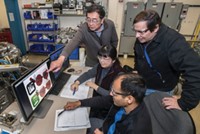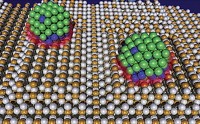Advertisement
Grab your lab coat. Let's get started
Welcome!
Welcome!
Create an account below to get 6 C&EN articles per month, receive newsletters and more - all free.
It seems this is your first time logging in online. Please enter the following information to continue.
As an ACS member you automatically get access to this site. All we need is few more details to create your reading experience.
Not you? Sign in with a different account.
Not you? Sign in with a different account.
ERROR 1
ERROR 1
ERROR 2
ERROR 2
ERROR 2
ERROR 2
ERROR 2
Password and Confirm password must match.
If you have an ACS member number, please enter it here so we can link this account to your membership. (optional)
ERROR 2
ACS values your privacy. By submitting your information, you are gaining access to C&EN and subscribing to our weekly newsletter. We use the information you provide to make your reading experience better, and we will never sell your data to third party members.
Synthesis
Iron Oxide Pins Gold Atoms In Place
Exceptional thermal stability makes system ideal for single-atom catalysis studies
by Mitch Jacoby
June 4, 2012
| A version of this story appeared in
Volume 90, Issue 23
Isolated gold atoms stay put on an iron oxide surface at temperatures of up to 400 °C, according to a study published in Physical Review Letters (DOI: 10.1103/PhysRevLett.108.216103). The finding may be used to prepare new model systems for surface chemistry investigations. Numerous studies have shown that oxide-supported gold particles in the low-nanometer size range catalyze oxidations and other reactions. Some researchers have proposed that these reactions are mediated by individual gold atoms, an idea that could have far-reaching industrial chemistry consequences. Testing that hypothesis has proven difficult because individual metal atoms on oxide surfaces tend to diffuse rapidly and agglomerate into nanosized chunks unless the surface is chilled to cryogenic temperatures, which are far too cold to study most chemical processes. On the basis of microscopy and spectroscopy analysis, Gareth S. Parkinson, Ulrike Diebold, and coworkers at Vienna University of Technology find that the (001) crystal face of Fe3O4 pins gold atoms at certain types of surface sites as a result of electronic interactions with Fe cations in the subsurface layer, and the gold atoms remain in place even as the temperature climbs to 400 °C.





Join the conversation
Contact the reporter
Submit a Letter to the Editor for publication
Engage with us on Twitter